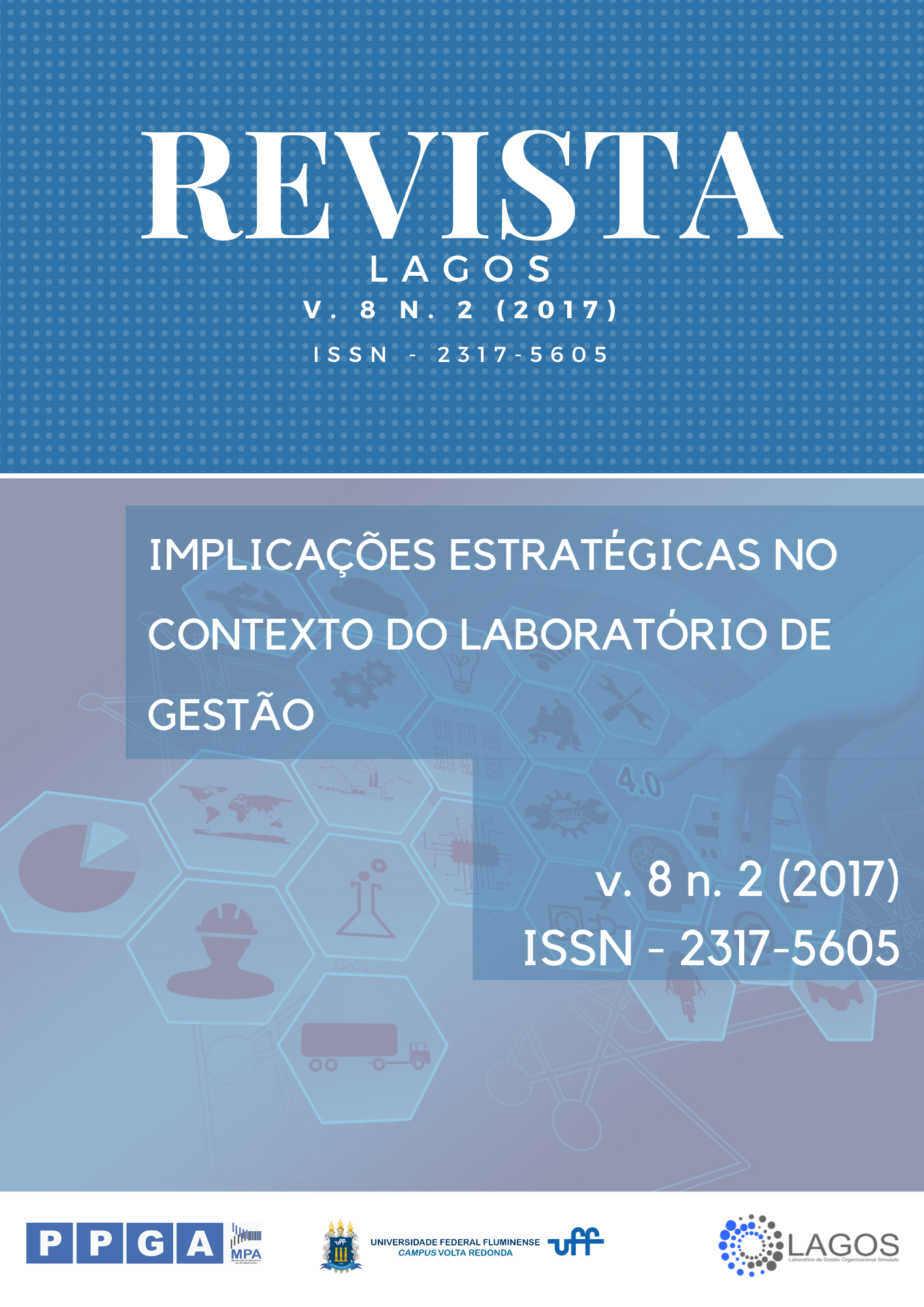Geração de Valor e Crescimento: algumas implicações do crescimento sobre a geração de valor de uma empresa
DOI:
https://doi.org/10.20401/lagos.8.2.271Keywords:
Avaliação de empresa, Estratégia de crescimento, Criação de valor.Abstract
As empresas buscam se expandir no mercado visando maximizar a riqueza dos acionistas. No ambiente de jogos simulados, a estratégia adotada foi de crescimento orgânico e para se manter saudável e obter uma geração de valor constante os gestores precisam utilizar de ferramentas para acompanhar como os investimentos e tomadas de decisões realizados têm influência nessa geração de valor. O texto trata de algumas dessas influências e aplica um modelo de avaliação do valor de uma empresa, pelo método baseado no EVA®, sobre uma indústria em um ambiente simulado de jogo de empresas, e busca compreender, relacionando a estratégia e o modelo de avaliação, sobre as implicações de crescimento organizacional e geração de valor à empresa no decorrer da gestão.References
BARNEY, J. Firm resources and sustained competitive advantage. Journal of management. v.17, n. 1, p. 99-120, 1991.
BOGDAN, R. S.; BIKEN, S. Investigação qualitativa em educação: uma introdução à teoria e aos métodos. 12.ed. Porto: Porto, 2003.
COMBS, J. G; CROOK, T. R; SHOOK, C. L. The dimension of organizational performance and its implications for strategic management research. In: D. J. KETCHEN, D. J; BERGH, D. D. (Orgs). Research methodology in strategy and management. San Diego: Elsevier, 2005.
COPELAND, T., KOLLER, T., MURRIN, J. Avaliação de Empresas – Valuation: Calculando e gerenciando o valor das empresas. 3. ed. São Paulo: Makron Books, 2002.
MCDEVITT, P. K. Measuring student learning using business simulations: a theory-based perspective. Developments in Business Simulation and Experiential Learning. v.24, p. 247-252, 1997.
FARIA, A. J. The changing nature of simulation research: a brief ABSEL history. Developments in Business Simulation and Experiential Learning, v.27, 2000.
GIL, A. C. Métodos e técnicas de pesquisa social. 5.ed. São Paulo: Atlas, 1999.
GITMAN, LAWRENCE J. Princípios de Administração Financeira. 12. ed. São Paulo: Person Prentice Hall, 2010.
HARRISON, J. S. Administração Estratégica de Recursos e Relacionamentos. Tradução Luciana de Oliveira da Rocha. Porto Alegre: Bookman, 2005.
HESS, E. D. The road to organic growth. How great companies consistently grow market share from within. New York, McGraw-Hill, 2007.
KAZANJIAN, R. K.; HESS, E. G.; DRAZIN, R. The search for organic growth. 2006.
LAKATOS, E. M.; MARCONI, M. A. Fundamentos metodologia científica. 4.ed. São Paulo: Atlas, 2001.
MARTINS, E. Avaliação de Empresas: da mensuração contábil à econômica. São Paulo: Atlas, 2001.
MIELCZARSKI, J. A. DE S. Aplicação do modelo de fluxo de caixa para definição do valor de mercado da empresa Linck Agroindustrial Ltda. [s.l.]. Universidade Federal do Rio Grande do Sul, 2003.
PENROSE, E. T. A teoria do crescimento da firma. Editora Unicamp, 2006.
RICHARDSON, R. J. Pesquisa social: métodos e técnicas. 3. ed. São Paulo: Atlas, 1999.
SAUAIA, A. C. A. Satisfação e aprendizagem em jogos de empresas - contribuições para a educação gerencial. 272p. Tese de Doutorado em Administração – Universidade de São Paulo, 2000.
SILVA, J. P. Análise financeiras das empresas. 11 ed. São Paulo, Atlas, 2012.
VASCONCELLOS, M. A. de. Introdução. In: BARBIERI, J. C. Organizações inovadoras: estudos e casos brasileiros. Rio de Janeiro: FGV, 2003.
VERSIANI, A.; FACHIN, Roberto C. Avaliando aprendizagem em simulações empresariais. Cad. EBAPE.BR. v. 5, n. spe, p. 01-13, 2007.
WRIGHT, P.; KROLL, M. J.; PARNELL, J. Administração estratégica: conceitos. Atlas, 2007
Downloads
Published
How to Cite
Issue
Section
License
Revista LAGOS, in accordance with Law No. 9,610, of February 19, 1998, which alters, updates and consolidates the legislation on copyright and takes other measures, adopts the following conditions of the Assignment of Copyright:
The Journal of the Simulated Organizational Management Laboratory (LAGOS) maintains, with the assignment of copyrights, the possession of the rights over the contents published by it;
The author retains his moral rights to the content, including the right to be identified as the author whenever the content is published;
Despite the attribution of copyright, the author retains the right to reuse the material in future collections of his own work free of charge. The acknowledgments of the previous publication in Revista LAGOS are the only requirements in such cases;
The author may make photocopies of the content, or distribute it by e-mail or fax, provided that they are intended for his own classes and for the purpose of meeting research objectives, provided that: (a) such copies are not resold and (b) reference to the original source of the publication and the name of Revista LAGOS are clearly indicated on all copies made of the material.
Revista LAGOS reserves the right to make changes in the originals in order to maintain the cultured standard of the language, while ensuring the style of the authors.
Published works become the property of Revista LAGOS.
The opinions expressed by the authors are their sole responsibility.











